HLTENN001: Exploring Features of the Australian Health Care System
VerifiedAdded on 2023/03/29
|11
|2441
|385
Report
AI Summary
This report provides an overview of the Australian healthcare system, addressing key aspects such as primary care programs like the Chronic Disease Self-Management Program (CDSMP) and its effectiveness. It discusses the advantages and disadvantages of Medicare, including low premiums and broad acceptance versus out-of-pocket costs and limited benefits. The report identifies immediate health-related needs for a patient named Marcus, focusing on smoking cessation, diabetes management, and the importance of private health insurance. It also examines political and social issues impacting indigenous health policy development, such as discrimination and structured inequities. Furthermore, the report analyzes the healthcare needs of a 75-year-old woman named Sita, including interdisciplinary care, the role of health insurance, and community health services available in Dandenong. Finally, it addresses cultural considerations in healthcare, emphasizing the importance of respecting Sita's traditional beliefs regarding hot and cold food principles while ensuring comprehensive medical care. Desklib provides a platform for students to access similar reports and solved assignments.
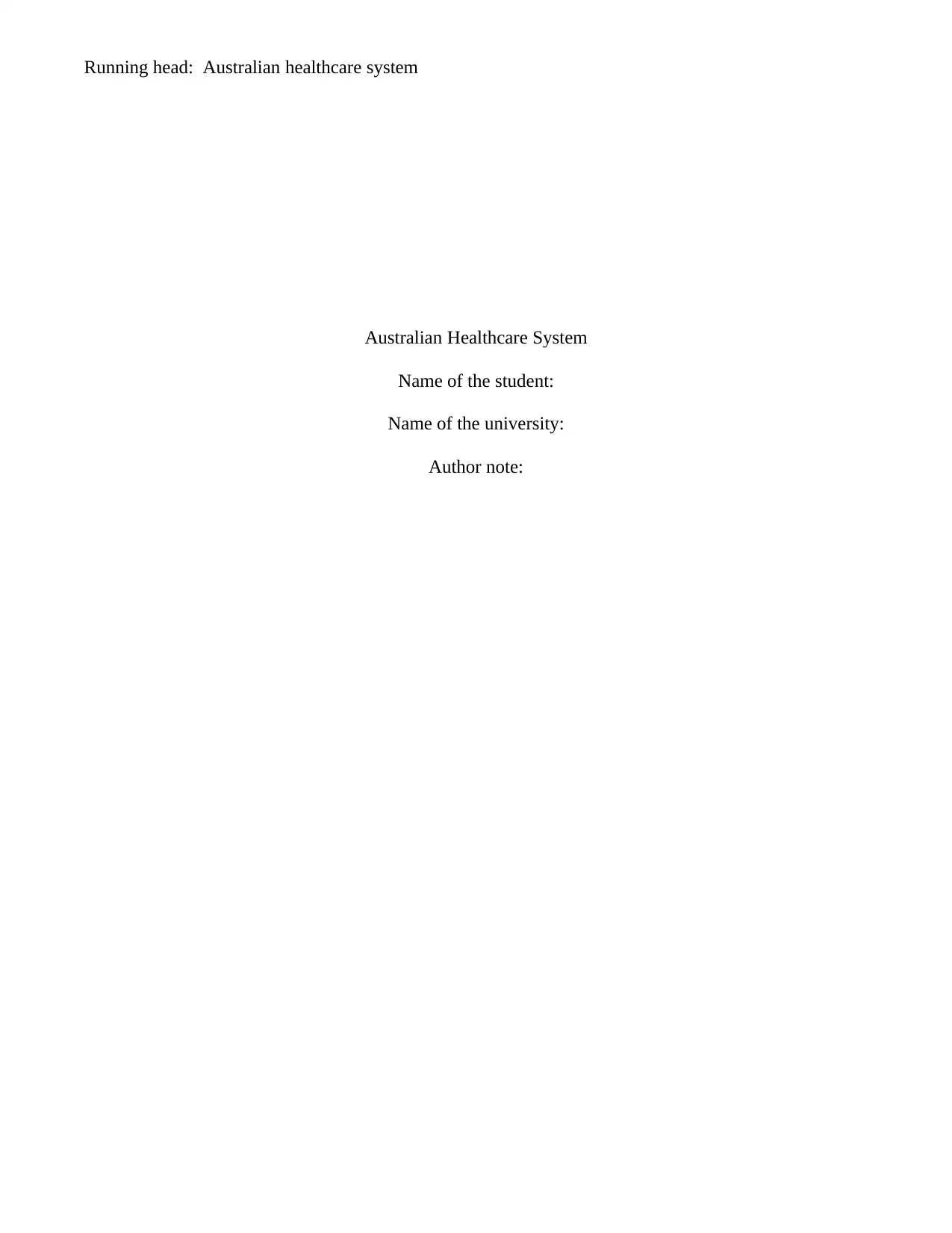
Running head: Australian healthcare system
Australian Healthcare System
Name of the student:
Name of the university:
Author note:
Australian Healthcare System
Name of the student:
Name of the university:
Author note:
Paraphrase This Document
Need a fresh take? Get an instant paraphrase of this document with our AI Paraphraser
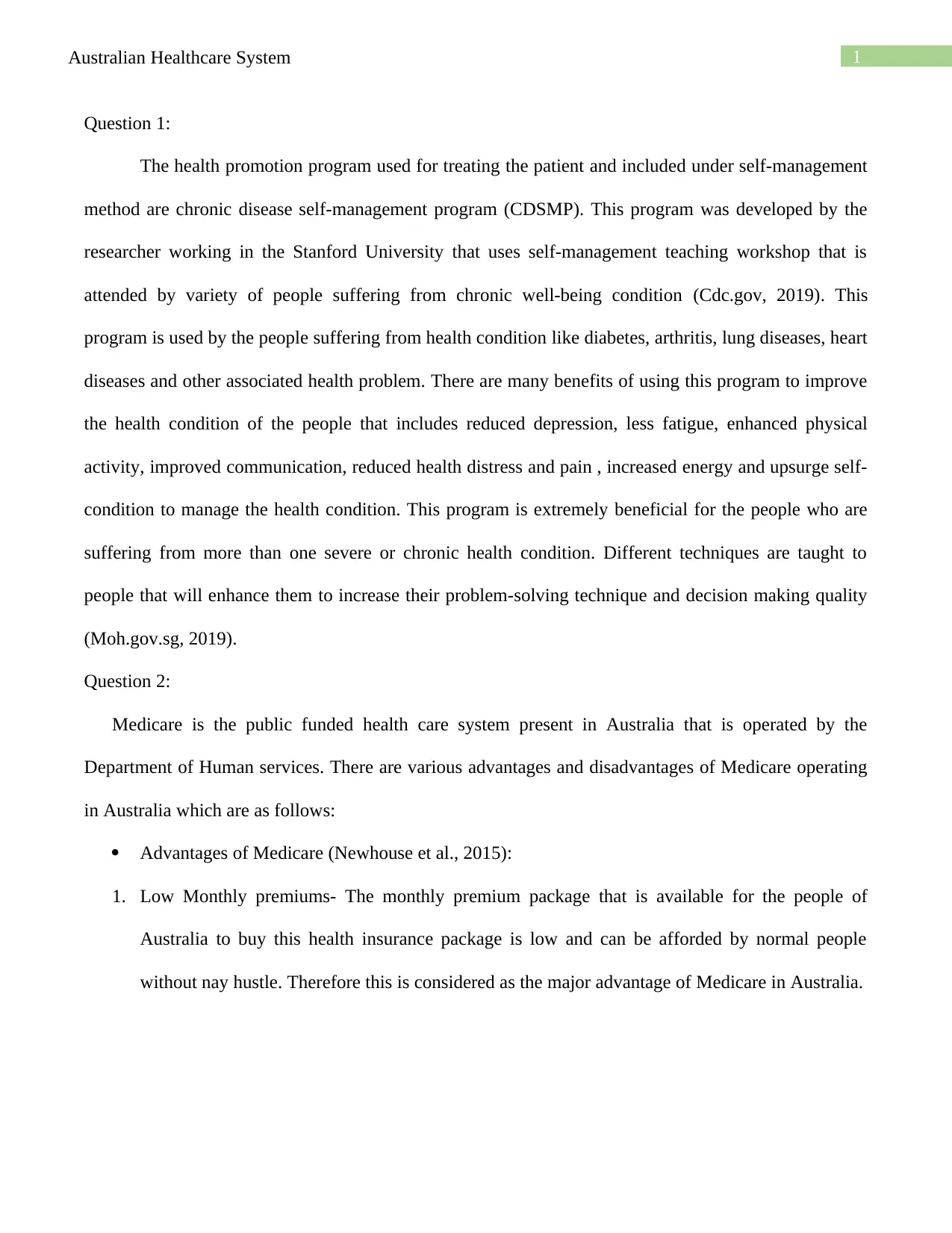
1Australian Healthcare System
Question 1:
The health promotion program used for treating the patient and included under self-management
method are chronic disease self-management program (CDSMP). This program was developed by the
researcher working in the Stanford University that uses self-management teaching workshop that is
attended by variety of people suffering from chronic well-being condition (Cdc.gov, 2019). This
program is used by the people suffering from health condition like diabetes, arthritis, lung diseases, heart
diseases and other associated health problem. There are many benefits of using this program to improve
the health condition of the people that includes reduced depression, less fatigue, enhanced physical
activity, improved communication, reduced health distress and pain , increased energy and upsurge self-
condition to manage the health condition. This program is extremely beneficial for the people who are
suffering from more than one severe or chronic health condition. Different techniques are taught to
people that will enhance them to increase their problem-solving technique and decision making quality
(Moh.gov.sg, 2019).
Question 2:
Medicare is the public funded health care system present in Australia that is operated by the
Department of Human services. There are various advantages and disadvantages of Medicare operating
in Australia which are as follows:
Advantages of Medicare (Newhouse et al., 2015):
1. Low Monthly premiums- The monthly premium package that is available for the people of
Australia to buy this health insurance package is low and can be afforded by normal people
without nay hustle. Therefore this is considered as the major advantage of Medicare in Australia.
Question 1:
The health promotion program used for treating the patient and included under self-management
method are chronic disease self-management program (CDSMP). This program was developed by the
researcher working in the Stanford University that uses self-management teaching workshop that is
attended by variety of people suffering from chronic well-being condition (Cdc.gov, 2019). This
program is used by the people suffering from health condition like diabetes, arthritis, lung diseases, heart
diseases and other associated health problem. There are many benefits of using this program to improve
the health condition of the people that includes reduced depression, less fatigue, enhanced physical
activity, improved communication, reduced health distress and pain , increased energy and upsurge self-
condition to manage the health condition. This program is extremely beneficial for the people who are
suffering from more than one severe or chronic health condition. Different techniques are taught to
people that will enhance them to increase their problem-solving technique and decision making quality
(Moh.gov.sg, 2019).
Question 2:
Medicare is the public funded health care system present in Australia that is operated by the
Department of Human services. There are various advantages and disadvantages of Medicare operating
in Australia which are as follows:
Advantages of Medicare (Newhouse et al., 2015):
1. Low Monthly premiums- The monthly premium package that is available for the people of
Australia to buy this health insurance package is low and can be afforded by normal people
without nay hustle. Therefore this is considered as the major advantage of Medicare in Australia.
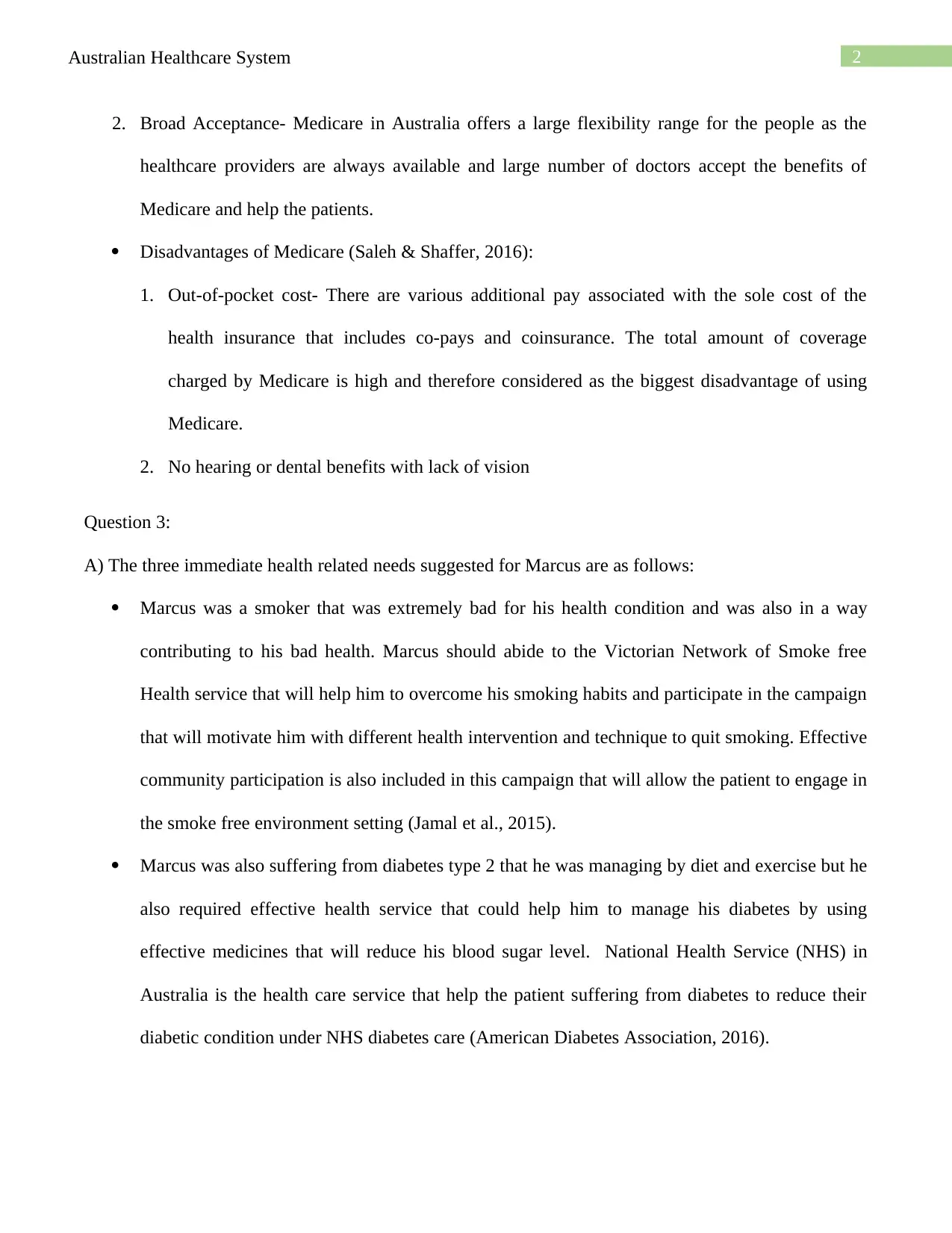
2Australian Healthcare System
2. Broad Acceptance- Medicare in Australia offers a large flexibility range for the people as the
healthcare providers are always available and large number of doctors accept the benefits of
Medicare and help the patients.
Disadvantages of Medicare (Saleh & Shaffer, 2016):
1. Out-of-pocket cost- There are various additional pay associated with the sole cost of the
health insurance that includes co-pays and coinsurance. The total amount of coverage
charged by Medicare is high and therefore considered as the biggest disadvantage of using
Medicare.
2. No hearing or dental benefits with lack of vision
Question 3:
A) The three immediate health related needs suggested for Marcus are as follows:
Marcus was a smoker that was extremely bad for his health condition and was also in a way
contributing to his bad health. Marcus should abide to the Victorian Network of Smoke free
Health service that will help him to overcome his smoking habits and participate in the campaign
that will motivate him with different health intervention and technique to quit smoking. Effective
community participation is also included in this campaign that will allow the patient to engage in
the smoke free environment setting (Jamal et al., 2015).
Marcus was also suffering from diabetes type 2 that he was managing by diet and exercise but he
also required effective health service that could help him to manage his diabetes by using
effective medicines that will reduce his blood sugar level. National Health Service (NHS) in
Australia is the health care service that help the patient suffering from diabetes to reduce their
diabetic condition under NHS diabetes care (American Diabetes Association, 2016).
2. Broad Acceptance- Medicare in Australia offers a large flexibility range for the people as the
healthcare providers are always available and large number of doctors accept the benefits of
Medicare and help the patients.
Disadvantages of Medicare (Saleh & Shaffer, 2016):
1. Out-of-pocket cost- There are various additional pay associated with the sole cost of the
health insurance that includes co-pays and coinsurance. The total amount of coverage
charged by Medicare is high and therefore considered as the biggest disadvantage of using
Medicare.
2. No hearing or dental benefits with lack of vision
Question 3:
A) The three immediate health related needs suggested for Marcus are as follows:
Marcus was a smoker that was extremely bad for his health condition and was also in a way
contributing to his bad health. Marcus should abide to the Victorian Network of Smoke free
Health service that will help him to overcome his smoking habits and participate in the campaign
that will motivate him with different health intervention and technique to quit smoking. Effective
community participation is also included in this campaign that will allow the patient to engage in
the smoke free environment setting (Jamal et al., 2015).
Marcus was also suffering from diabetes type 2 that he was managing by diet and exercise but he
also required effective health service that could help him to manage his diabetes by using
effective medicines that will reduce his blood sugar level. National Health Service (NHS) in
Australia is the health care service that help the patient suffering from diabetes to reduce their
diabetic condition under NHS diabetes care (American Diabetes Association, 2016).
⊘ This is a preview!⊘
Do you want full access?
Subscribe today to unlock all pages.

Trusted by 1+ million students worldwide

3Australian Healthcare System
Marcus left his job and was receiving pension that was helpful for him to manage his life and bad
health condition. He did not opt for any private health insurance that was the major need that
must be adapted by Marcus as this will allow him to treat his health condition in a better way.
Medicare was the health care system helpful for the people to treat and assist their health
condition for a better living (Milani & Lavie, 2015).
B) The two political and social issues that might impact the health policy development of the
indigenous people are as follows:
There is a major discrimination faced by the people of indigenous group where the doctors
are also not supportive to treat the patient who belong to such groups and hence the bad
health rate condition is increasing among such people leading to the major social issue.
Different community health programmers are not ready to accept such group of people under
their setting thereby increasing the situation of discrimination among them (Browne et al.,
2016).
Structured inequities present within the society is also one of the social issue faced by this
group of people that comprises of unequal wealth, status, power and income distribution and
the inequality received by the women under low socioeconomic health condition (Bakers et
al., 2018).
Question 4:
A)
Sita was 75 old women who was staying with her granddaughter Anita, who was 25 years old
and was born in Australia whereas Sita had moved to Australia 10 years ago and was suffering from
myocardial infraction that was worse and she required extreme care and support. As Anita was already
Marcus left his job and was receiving pension that was helpful for him to manage his life and bad
health condition. He did not opt for any private health insurance that was the major need that
must be adapted by Marcus as this will allow him to treat his health condition in a better way.
Medicare was the health care system helpful for the people to treat and assist their health
condition for a better living (Milani & Lavie, 2015).
B) The two political and social issues that might impact the health policy development of the
indigenous people are as follows:
There is a major discrimination faced by the people of indigenous group where the doctors
are also not supportive to treat the patient who belong to such groups and hence the bad
health rate condition is increasing among such people leading to the major social issue.
Different community health programmers are not ready to accept such group of people under
their setting thereby increasing the situation of discrimination among them (Browne et al.,
2016).
Structured inequities present within the society is also one of the social issue faced by this
group of people that comprises of unequal wealth, status, power and income distribution and
the inequality received by the women under low socioeconomic health condition (Bakers et
al., 2018).
Question 4:
A)
Sita was 75 old women who was staying with her granddaughter Anita, who was 25 years old
and was born in Australia whereas Sita had moved to Australia 10 years ago and was suffering from
myocardial infraction that was worse and she required extreme care and support. As Anita was already
Paraphrase This Document
Need a fresh take? Get an instant paraphrase of this document with our AI Paraphraser
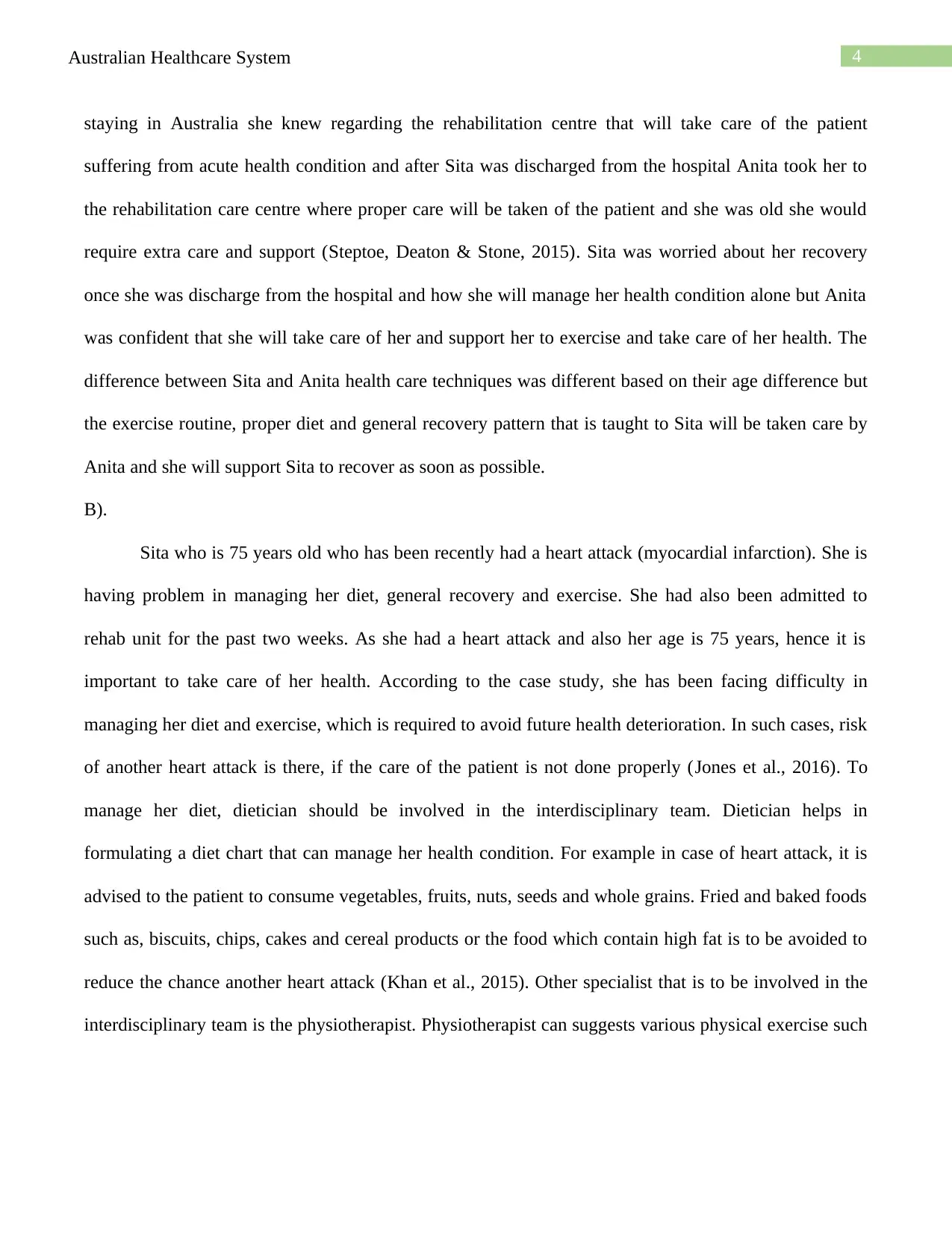
4Australian Healthcare System
staying in Australia she knew regarding the rehabilitation centre that will take care of the patient
suffering from acute health condition and after Sita was discharged from the hospital Anita took her to
the rehabilitation care centre where proper care will be taken of the patient and she was old she would
require extra care and support (Steptoe, Deaton & Stone, 2015). Sita was worried about her recovery
once she was discharge from the hospital and how she will manage her health condition alone but Anita
was confident that she will take care of her and support her to exercise and take care of her health. The
difference between Sita and Anita health care techniques was different based on their age difference but
the exercise routine, proper diet and general recovery pattern that is taught to Sita will be taken care by
Anita and she will support Sita to recover as soon as possible.
B).
Sita who is 75 years old who has been recently had a heart attack (myocardial infarction). She is
having problem in managing her diet, general recovery and exercise. She had also been admitted to
rehab unit for the past two weeks. As she had a heart attack and also her age is 75 years, hence it is
important to take care of her health. According to the case study, she has been facing difficulty in
managing her diet and exercise, which is required to avoid future health deterioration. In such cases, risk
of another heart attack is there, if the care of the patient is not done properly (Jones et al., 2016). To
manage her diet, dietician should be involved in the interdisciplinary team. Dietician helps in
formulating a diet chart that can manage her health condition. For example in case of heart attack, it is
advised to the patient to consume vegetables, fruits, nuts, seeds and whole grains. Fried and baked foods
such as, biscuits, chips, cakes and cereal products or the food which contain high fat is to be avoided to
reduce the chance another heart attack (Khan et al., 2015). Other specialist that is to be involved in the
interdisciplinary team is the physiotherapist. Physiotherapist can suggests various physical exercise such
staying in Australia she knew regarding the rehabilitation centre that will take care of the patient
suffering from acute health condition and after Sita was discharged from the hospital Anita took her to
the rehabilitation care centre where proper care will be taken of the patient and she was old she would
require extra care and support (Steptoe, Deaton & Stone, 2015). Sita was worried about her recovery
once she was discharge from the hospital and how she will manage her health condition alone but Anita
was confident that she will take care of her and support her to exercise and take care of her health. The
difference between Sita and Anita health care techniques was different based on their age difference but
the exercise routine, proper diet and general recovery pattern that is taught to Sita will be taken care by
Anita and she will support Sita to recover as soon as possible.
B).
Sita who is 75 years old who has been recently had a heart attack (myocardial infarction). She is
having problem in managing her diet, general recovery and exercise. She had also been admitted to
rehab unit for the past two weeks. As she had a heart attack and also her age is 75 years, hence it is
important to take care of her health. According to the case study, she has been facing difficulty in
managing her diet and exercise, which is required to avoid future health deterioration. In such cases, risk
of another heart attack is there, if the care of the patient is not done properly (Jones et al., 2016). To
manage her diet, dietician should be involved in the interdisciplinary team. Dietician helps in
formulating a diet chart that can manage her health condition. For example in case of heart attack, it is
advised to the patient to consume vegetables, fruits, nuts, seeds and whole grains. Fried and baked foods
such as, biscuits, chips, cakes and cereal products or the food which contain high fat is to be avoided to
reduce the chance another heart attack (Khan et al., 2015). Other specialist that is to be involved in the
interdisciplinary team is the physiotherapist. Physiotherapist can suggests various physical exercise such

5Australian Healthcare System
as, walking which reduces the chances of heart attack and also helps in managing the blood pressure
(Anderson et al., 2016).
C)
Health insurance is defined as the type of coverage of insurance which cover all the medical
expenses and other surgical expenses. It also covers the expenses of any illness or injury caused to an
individual. Sita is 75 years old women, hence, health insurance is extremely important to her as chances
of any illness and injury is more. According to the case study, sita has a health insurance, which can
decrease her expenses in the treatment. She recently had a myocardial infarction, hence she had to rely
on number of medication. She also has to manage the regular appointments with the general practitioner.
As she is 75 years old, there are chances that she might get another heart attack. With the help of health
insurance she can save from such expenses. Sita is also having problem in managing her diet and
exercise, hence requires the involvement of interdisciplinary team such as dietician and physiotherapist
which requires additional cost (Lichtman et al., 2015). These additional cost can be avoided by using the
health insurance. Hence, it can be stated that with the help of health insurance, her health expenses can
be decreased.
D)
Sita, who is 75 years old lives in Dandenong. She is originally from India and moved to
Australia 10 years ago and now resides in Dandenong. Dandenong is located in Australia in the suburb
of the Melbourne, Victoria. In Dandenong, there are a number of community health services that can
help sita in accessing the primary health care needs. Dandenong have health care facilities for the heart
patient, such as, heart scope Victoria, hence from such healthcare centre she can manage her heart
condition. There are other healthcare centres also which provides facilities for the exercise in older
patient. She can rely on that community services for the maintenance of her health condition by the help
as, walking which reduces the chances of heart attack and also helps in managing the blood pressure
(Anderson et al., 2016).
C)
Health insurance is defined as the type of coverage of insurance which cover all the medical
expenses and other surgical expenses. It also covers the expenses of any illness or injury caused to an
individual. Sita is 75 years old women, hence, health insurance is extremely important to her as chances
of any illness and injury is more. According to the case study, sita has a health insurance, which can
decrease her expenses in the treatment. She recently had a myocardial infarction, hence she had to rely
on number of medication. She also has to manage the regular appointments with the general practitioner.
As she is 75 years old, there are chances that she might get another heart attack. With the help of health
insurance she can save from such expenses. Sita is also having problem in managing her diet and
exercise, hence requires the involvement of interdisciplinary team such as dietician and physiotherapist
which requires additional cost (Lichtman et al., 2015). These additional cost can be avoided by using the
health insurance. Hence, it can be stated that with the help of health insurance, her health expenses can
be decreased.
D)
Sita, who is 75 years old lives in Dandenong. She is originally from India and moved to
Australia 10 years ago and now resides in Dandenong. Dandenong is located in Australia in the suburb
of the Melbourne, Victoria. In Dandenong, there are a number of community health services that can
help sita in accessing the primary health care needs. Dandenong have health care facilities for the heart
patient, such as, heart scope Victoria, hence from such healthcare centre she can manage her heart
condition. There are other healthcare centres also which provides facilities for the exercise in older
patient. She can rely on that community services for the maintenance of her health condition by the help
⊘ This is a preview!⊘
Do you want full access?
Subscribe today to unlock all pages.

Trusted by 1+ million students worldwide
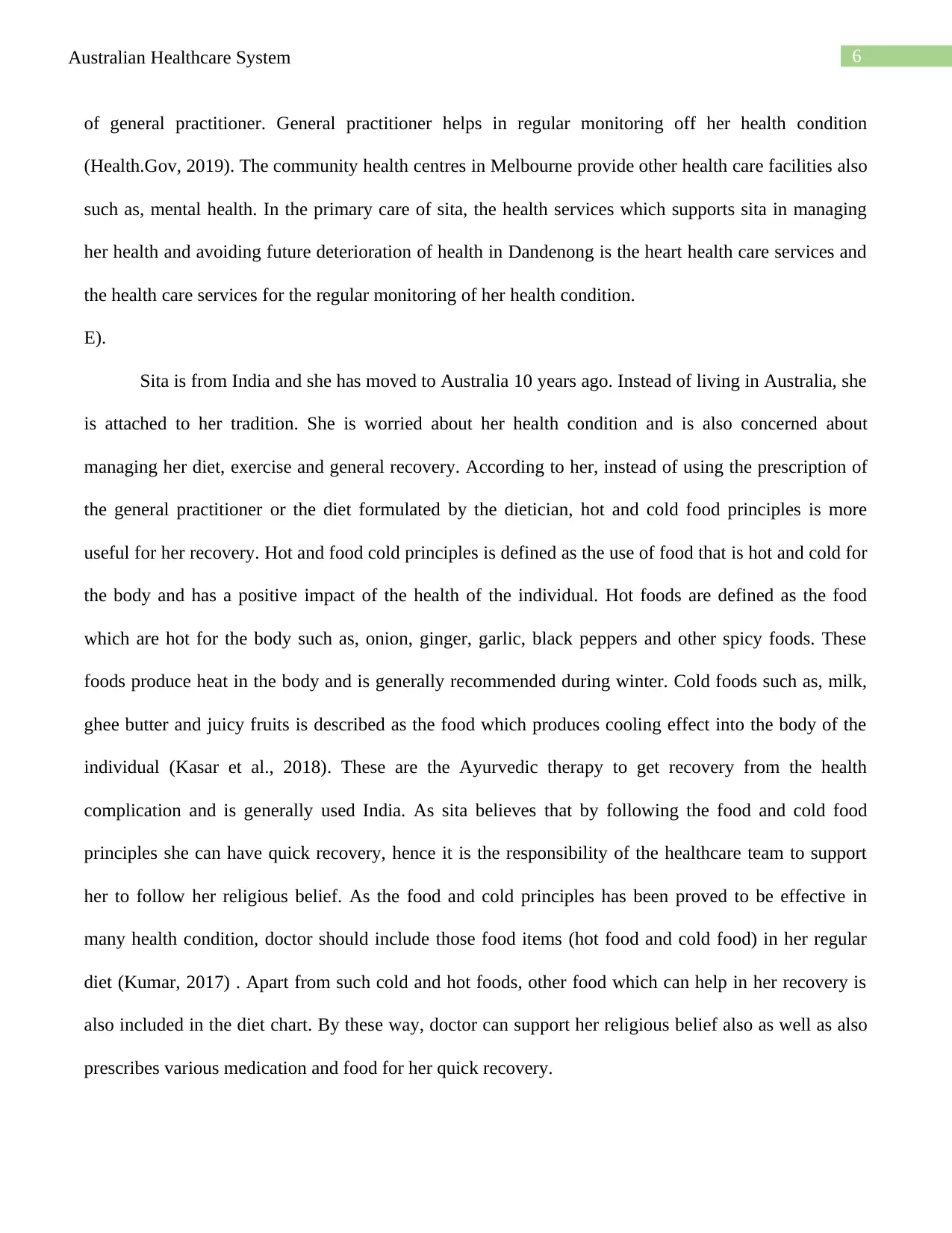
6Australian Healthcare System
of general practitioner. General practitioner helps in regular monitoring off her health condition
(Health.Gov, 2019). The community health centres in Melbourne provide other health care facilities also
such as, mental health. In the primary care of sita, the health services which supports sita in managing
her health and avoiding future deterioration of health in Dandenong is the heart health care services and
the health care services for the regular monitoring of her health condition.
E).
Sita is from India and she has moved to Australia 10 years ago. Instead of living in Australia, she
is attached to her tradition. She is worried about her health condition and is also concerned about
managing her diet, exercise and general recovery. According to her, instead of using the prescription of
the general practitioner or the diet formulated by the dietician, hot and cold food principles is more
useful for her recovery. Hot and food cold principles is defined as the use of food that is hot and cold for
the body and has a positive impact of the health of the individual. Hot foods are defined as the food
which are hot for the body such as, onion, ginger, garlic, black peppers and other spicy foods. These
foods produce heat in the body and is generally recommended during winter. Cold foods such as, milk,
ghee butter and juicy fruits is described as the food which produces cooling effect into the body of the
individual (Kasar et al., 2018). These are the Ayurvedic therapy to get recovery from the health
complication and is generally used India. As sita believes that by following the food and cold food
principles she can have quick recovery, hence it is the responsibility of the healthcare team to support
her to follow her religious belief. As the food and cold principles has been proved to be effective in
many health condition, doctor should include those food items (hot food and cold food) in her regular
diet (Kumar, 2017) . Apart from such cold and hot foods, other food which can help in her recovery is
also included in the diet chart. By these way, doctor can support her religious belief also as well as also
prescribes various medication and food for her quick recovery.
of general practitioner. General practitioner helps in regular monitoring off her health condition
(Health.Gov, 2019). The community health centres in Melbourne provide other health care facilities also
such as, mental health. In the primary care of sita, the health services which supports sita in managing
her health and avoiding future deterioration of health in Dandenong is the heart health care services and
the health care services for the regular monitoring of her health condition.
E).
Sita is from India and she has moved to Australia 10 years ago. Instead of living in Australia, she
is attached to her tradition. She is worried about her health condition and is also concerned about
managing her diet, exercise and general recovery. According to her, instead of using the prescription of
the general practitioner or the diet formulated by the dietician, hot and cold food principles is more
useful for her recovery. Hot and food cold principles is defined as the use of food that is hot and cold for
the body and has a positive impact of the health of the individual. Hot foods are defined as the food
which are hot for the body such as, onion, ginger, garlic, black peppers and other spicy foods. These
foods produce heat in the body and is generally recommended during winter. Cold foods such as, milk,
ghee butter and juicy fruits is described as the food which produces cooling effect into the body of the
individual (Kasar et al., 2018). These are the Ayurvedic therapy to get recovery from the health
complication and is generally used India. As sita believes that by following the food and cold food
principles she can have quick recovery, hence it is the responsibility of the healthcare team to support
her to follow her religious belief. As the food and cold principles has been proved to be effective in
many health condition, doctor should include those food items (hot food and cold food) in her regular
diet (Kumar, 2017) . Apart from such cold and hot foods, other food which can help in her recovery is
also included in the diet chart. By these way, doctor can support her religious belief also as well as also
prescribes various medication and food for her quick recovery.
Paraphrase This Document
Need a fresh take? Get an instant paraphrase of this document with our AI Paraphraser
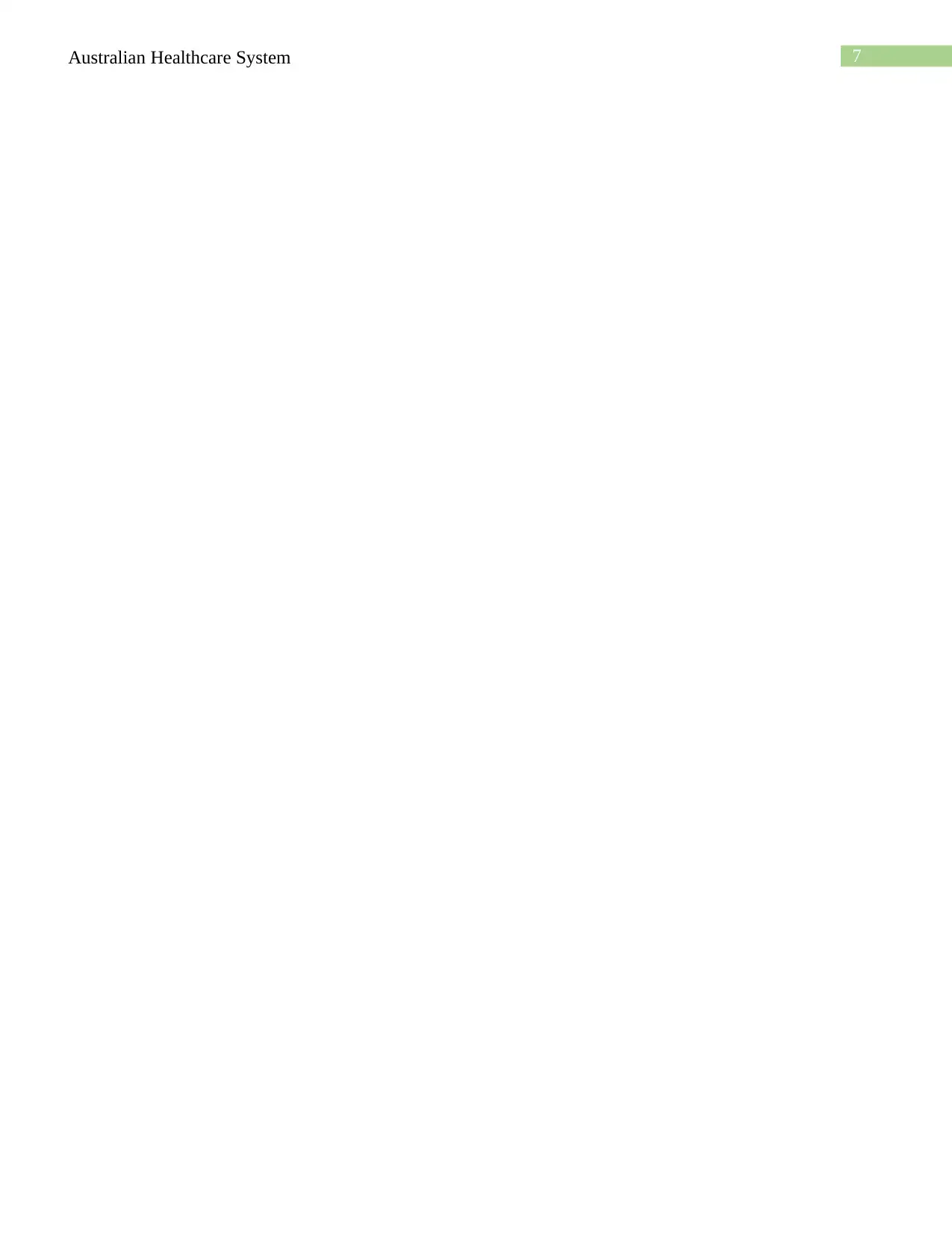
7Australian Healthcare System
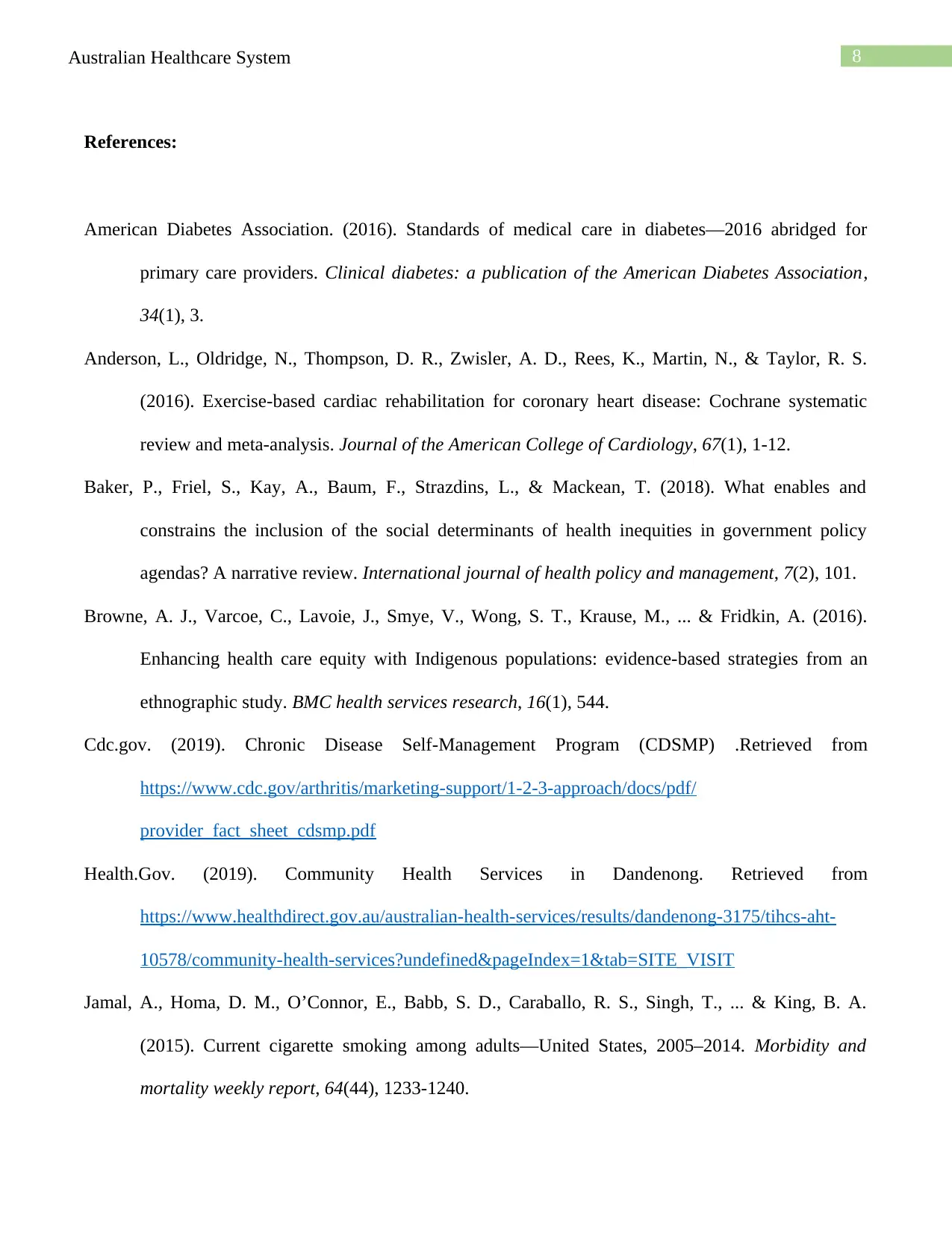
8Australian Healthcare System
References:
American Diabetes Association. (2016). Standards of medical care in diabetes—2016 abridged for
primary care providers. Clinical diabetes: a publication of the American Diabetes Association,
34(1), 3.
Anderson, L., Oldridge, N., Thompson, D. R., Zwisler, A. D., Rees, K., Martin, N., & Taylor, R. S.
(2016). Exercise-based cardiac rehabilitation for coronary heart disease: Cochrane systematic
review and meta-analysis. Journal of the American College of Cardiology, 67(1), 1-12.
Baker, P., Friel, S., Kay, A., Baum, F., Strazdins, L., & Mackean, T. (2018). What enables and
constrains the inclusion of the social determinants of health inequities in government policy
agendas? A narrative review. International journal of health policy and management, 7(2), 101.
Browne, A. J., Varcoe, C., Lavoie, J., Smye, V., Wong, S. T., Krause, M., ... & Fridkin, A. (2016).
Enhancing health care equity with Indigenous populations: evidence-based strategies from an
ethnographic study. BMC health services research, 16(1), 544.
Cdc.gov. (2019). Chronic Disease Self-Management Program (CDSMP) .Retrieved from
https://www.cdc.gov/arthritis/marketing-support/1-2-3-approach/docs/pdf/
provider_fact_sheet_cdsmp.pdf
Health.Gov. (2019). Community Health Services in Dandenong. Retrieved from
https://www.healthdirect.gov.au/australian-health-services/results/dandenong-3175/tihcs-aht-
10578/community-health-services?undefined&pageIndex=1&tab=SITE_VISIT
Jamal, A., Homa, D. M., O’Connor, E., Babb, S. D., Caraballo, R. S., Singh, T., ... & King, B. A.
(2015). Current cigarette smoking among adults—United States, 2005–2014. Morbidity and
mortality weekly report, 64(44), 1233-1240.
References:
American Diabetes Association. (2016). Standards of medical care in diabetes—2016 abridged for
primary care providers. Clinical diabetes: a publication of the American Diabetes Association,
34(1), 3.
Anderson, L., Oldridge, N., Thompson, D. R., Zwisler, A. D., Rees, K., Martin, N., & Taylor, R. S.
(2016). Exercise-based cardiac rehabilitation for coronary heart disease: Cochrane systematic
review and meta-analysis. Journal of the American College of Cardiology, 67(1), 1-12.
Baker, P., Friel, S., Kay, A., Baum, F., Strazdins, L., & Mackean, T. (2018). What enables and
constrains the inclusion of the social determinants of health inequities in government policy
agendas? A narrative review. International journal of health policy and management, 7(2), 101.
Browne, A. J., Varcoe, C., Lavoie, J., Smye, V., Wong, S. T., Krause, M., ... & Fridkin, A. (2016).
Enhancing health care equity with Indigenous populations: evidence-based strategies from an
ethnographic study. BMC health services research, 16(1), 544.
Cdc.gov. (2019). Chronic Disease Self-Management Program (CDSMP) .Retrieved from
https://www.cdc.gov/arthritis/marketing-support/1-2-3-approach/docs/pdf/
provider_fact_sheet_cdsmp.pdf
Health.Gov. (2019). Community Health Services in Dandenong. Retrieved from
https://www.healthdirect.gov.au/australian-health-services/results/dandenong-3175/tihcs-aht-
10578/community-health-services?undefined&pageIndex=1&tab=SITE_VISIT
Jamal, A., Homa, D. M., O’Connor, E., Babb, S. D., Caraballo, R. S., Singh, T., ... & King, B. A.
(2015). Current cigarette smoking among adults—United States, 2005–2014. Morbidity and
mortality weekly report, 64(44), 1233-1240.
⊘ This is a preview!⊘
Do you want full access?
Subscribe today to unlock all pages.

Trusted by 1+ million students worldwide
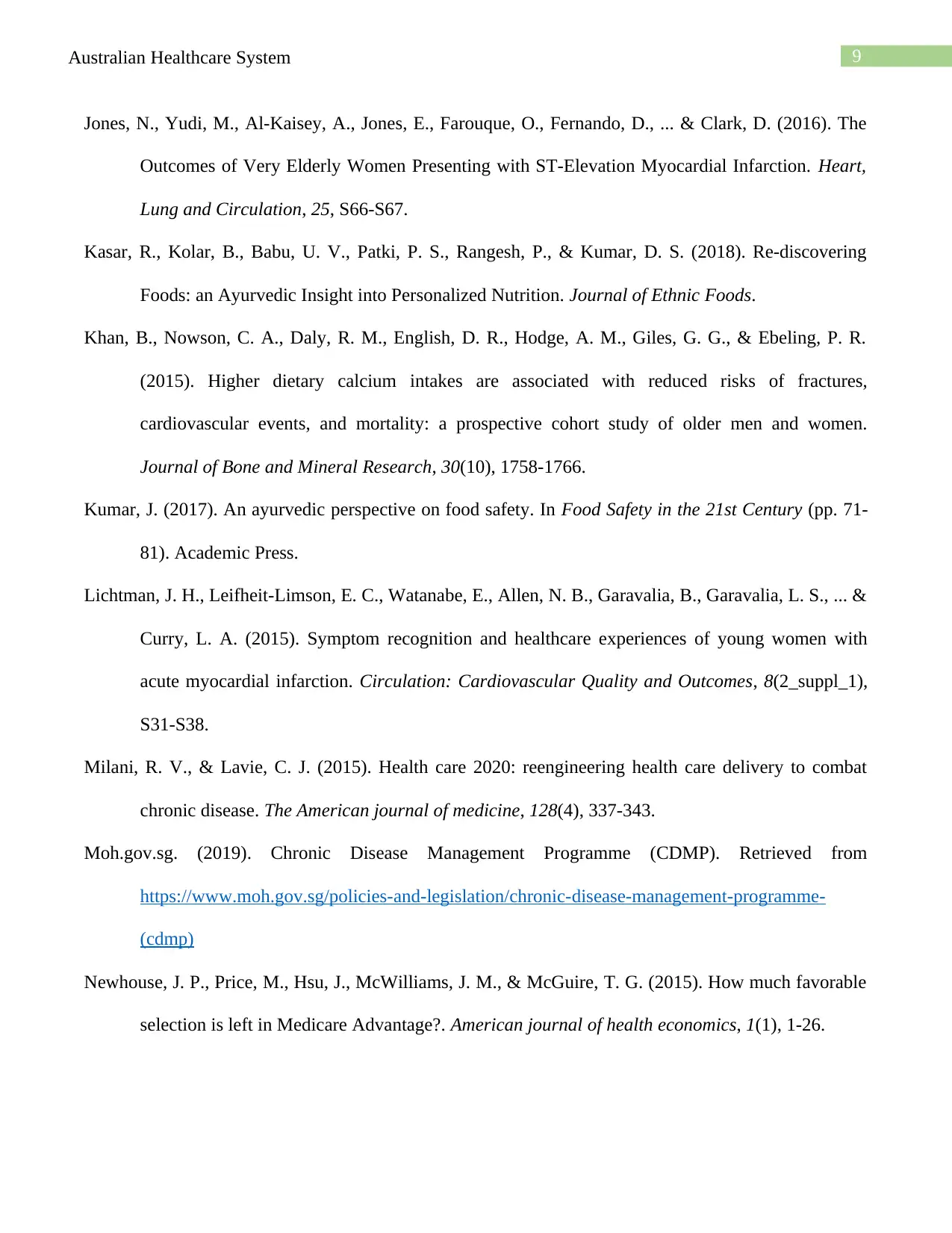
9Australian Healthcare System
Jones, N., Yudi, M., Al-Kaisey, A., Jones, E., Farouque, O., Fernando, D., ... & Clark, D. (2016). The
Outcomes of Very Elderly Women Presenting with ST-Elevation Myocardial Infarction. Heart,
Lung and Circulation, 25, S66-S67.
Kasar, R., Kolar, B., Babu, U. V., Patki, P. S., Rangesh, P., & Kumar, D. S. (2018). Re-discovering
Foods: an Ayurvedic Insight into Personalized Nutrition. Journal of Ethnic Foods.
Khan, B., Nowson, C. A., Daly, R. M., English, D. R., Hodge, A. M., Giles, G. G., & Ebeling, P. R.
(2015). Higher dietary calcium intakes are associated with reduced risks of fractures,
cardiovascular events, and mortality: a prospective cohort study of older men and women.
Journal of Bone and Mineral Research, 30(10), 1758-1766.
Kumar, J. (2017). An ayurvedic perspective on food safety. In Food Safety in the 21st Century (pp. 71-
81). Academic Press.
Lichtman, J. H., Leifheit-Limson, E. C., Watanabe, E., Allen, N. B., Garavalia, B., Garavalia, L. S., ... &
Curry, L. A. (2015). Symptom recognition and healthcare experiences of young women with
acute myocardial infarction. Circulation: Cardiovascular Quality and Outcomes, 8(2_suppl_1),
S31-S38.
Milani, R. V., & Lavie, C. J. (2015). Health care 2020: reengineering health care delivery to combat
chronic disease. The American journal of medicine, 128(4), 337-343.
Moh.gov.sg. (2019). Chronic Disease Management Programme (CDMP). Retrieved from
https://www.moh.gov.sg/policies-and-legislation/chronic-disease-management-programme-
(cdmp)
Newhouse, J. P., Price, M., Hsu, J., McWilliams, J. M., & McGuire, T. G. (2015). How much favorable
selection is left in Medicare Advantage?. American journal of health economics, 1(1), 1-26.
Jones, N., Yudi, M., Al-Kaisey, A., Jones, E., Farouque, O., Fernando, D., ... & Clark, D. (2016). The
Outcomes of Very Elderly Women Presenting with ST-Elevation Myocardial Infarction. Heart,
Lung and Circulation, 25, S66-S67.
Kasar, R., Kolar, B., Babu, U. V., Patki, P. S., Rangesh, P., & Kumar, D. S. (2018). Re-discovering
Foods: an Ayurvedic Insight into Personalized Nutrition. Journal of Ethnic Foods.
Khan, B., Nowson, C. A., Daly, R. M., English, D. R., Hodge, A. M., Giles, G. G., & Ebeling, P. R.
(2015). Higher dietary calcium intakes are associated with reduced risks of fractures,
cardiovascular events, and mortality: a prospective cohort study of older men and women.
Journal of Bone and Mineral Research, 30(10), 1758-1766.
Kumar, J. (2017). An ayurvedic perspective on food safety. In Food Safety in the 21st Century (pp. 71-
81). Academic Press.
Lichtman, J. H., Leifheit-Limson, E. C., Watanabe, E., Allen, N. B., Garavalia, B., Garavalia, L. S., ... &
Curry, L. A. (2015). Symptom recognition and healthcare experiences of young women with
acute myocardial infarction. Circulation: Cardiovascular Quality and Outcomes, 8(2_suppl_1),
S31-S38.
Milani, R. V., & Lavie, C. J. (2015). Health care 2020: reengineering health care delivery to combat
chronic disease. The American journal of medicine, 128(4), 337-343.
Moh.gov.sg. (2019). Chronic Disease Management Programme (CDMP). Retrieved from
https://www.moh.gov.sg/policies-and-legislation/chronic-disease-management-programme-
(cdmp)
Newhouse, J. P., Price, M., Hsu, J., McWilliams, J. M., & McGuire, T. G. (2015). How much favorable
selection is left in Medicare Advantage?. American journal of health economics, 1(1), 1-26.
Paraphrase This Document
Need a fresh take? Get an instant paraphrase of this document with our AI Paraphraser
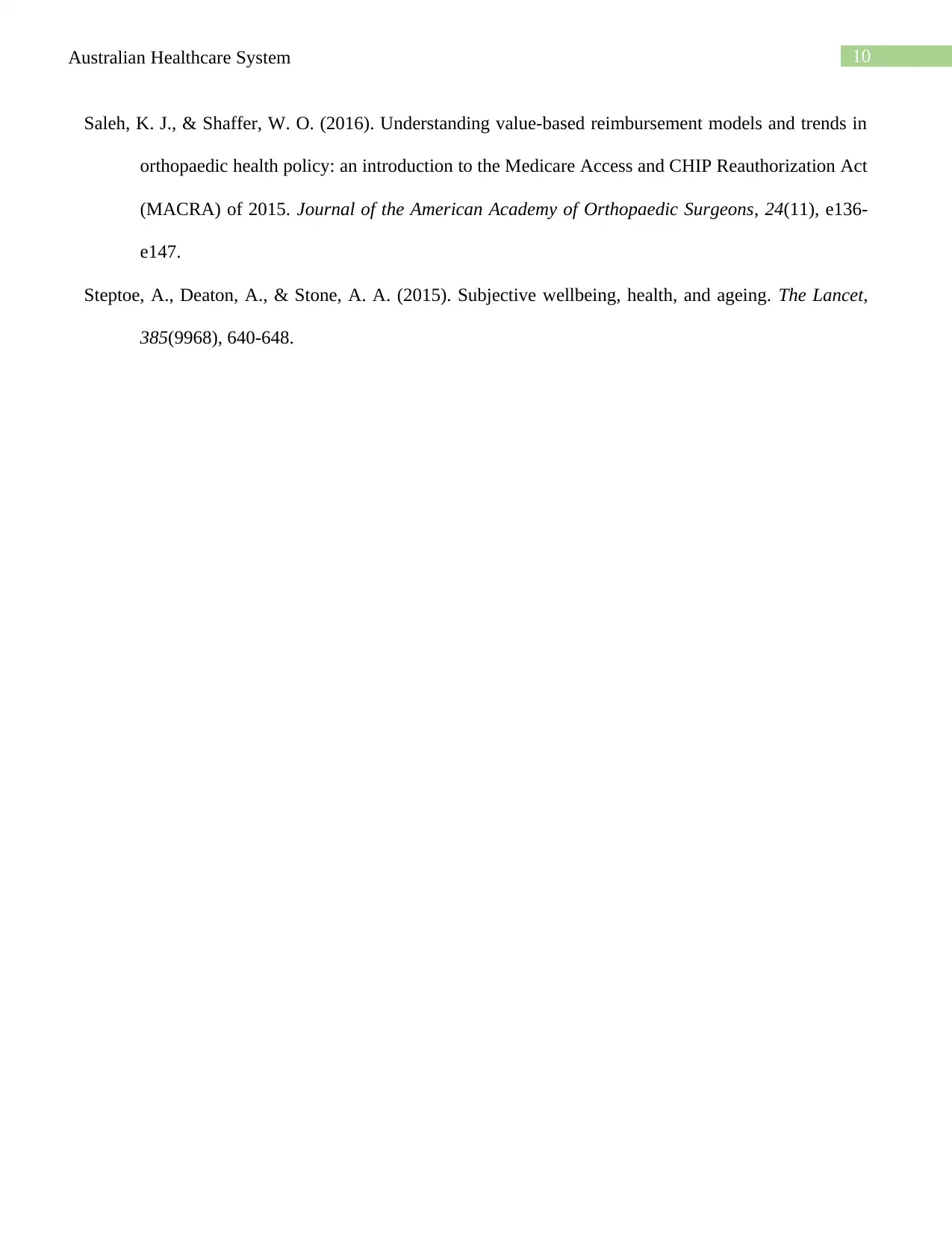
10Australian Healthcare System
Saleh, K. J., & Shaffer, W. O. (2016). Understanding value-based reimbursement models and trends in
orthopaedic health policy: an introduction to the Medicare Access and CHIP Reauthorization Act
(MACRA) of 2015. Journal of the American Academy of Orthopaedic Surgeons, 24(11), e136-
e147.
Steptoe, A., Deaton, A., & Stone, A. A. (2015). Subjective wellbeing, health, and ageing. The Lancet,
385(9968), 640-648.
Saleh, K. J., & Shaffer, W. O. (2016). Understanding value-based reimbursement models and trends in
orthopaedic health policy: an introduction to the Medicare Access and CHIP Reauthorization Act
(MACRA) of 2015. Journal of the American Academy of Orthopaedic Surgeons, 24(11), e136-
e147.
Steptoe, A., Deaton, A., & Stone, A. A. (2015). Subjective wellbeing, health, and ageing. The Lancet,
385(9968), 640-648.
1 out of 11
Related Documents
Your All-in-One AI-Powered Toolkit for Academic Success.
+13062052269
info@desklib.com
Available 24*7 on WhatsApp / Email
![[object Object]](/_next/static/media/star-bottom.7253800d.svg)
Unlock your academic potential
Copyright © 2020–2025 A2Z Services. All Rights Reserved. Developed and managed by ZUCOL.





